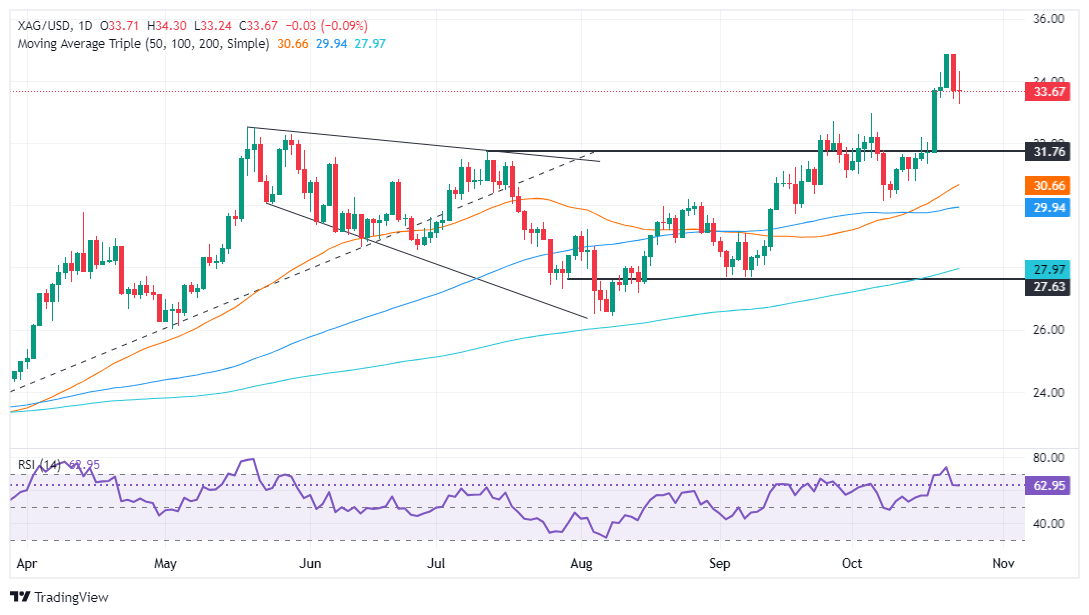Silver Price Forecast: XAG/USD consolidates around $33.60 amid falling US yields
- Silver price recovers from a four-day low but remains stuck in a $1 range, failing to capitalize on a weaker US Dollar and falling yields.
- Momentum supports buyers, with RSI in bullish territory, as XAG/USD targets the YTD high of $34.86 and beyond.
- A break below $33.25 could shift bias to neutral, with further support at $33.00 and the October 17 low of $31.32.
Silver consolidated at around $33.60 as grey metal bulls failed to capitalize on falling US yields and a weak US Dollar. At the time of writing, XAG/USD is seesawing within a $1 range and virtually unchanged.
XAG/USD Price Forecast: Technical outlook
Silver price recovered some ground after falling to a four-day low of $33.25. The uptrend remains intact, and if buyers lift the XAG/USD spot price above $34.00 a troy ounce, they could challenge the year-to-date (YTD) high at $34.86.
Momentum backs buyers, with the Relative Strength Index (RSI) persisting in bullish territory.
If XAG/USD clears the YTD high, the next key resistance levels would be the October 2012 peak at $35.40, ahead of challenging the psychological $40.00, and the August 2011 high at $44.22.
Conversely, if the grey metal drops below $33.25, the next support would be $33.00. The break below could shift the bias to neutral, and if sellers drive Silver’s below October 17 low of $31.32, XAG/USD might reach the 50-day Simple Moving Average (SMA) at $30.64.
XAG/USD Price Chart – Daily

Silver FAQs
Silver is a precious metal highly traded among investors. It has been historically used as a store of value and a medium of exchange. Although less popular than Gold, traders may turn to Silver to diversify their investment portfolio, for its intrinsic value or as a potential hedge during high-inflation periods. Investors can buy physical Silver, in coins or in bars, or trade it through vehicles such as Exchange Traded Funds, which track its price on international markets.
Silver prices can move due to a wide range of factors. Geopolitical instability or fears of a deep recession can make Silver price escalate due to its safe-haven status, although to a lesser extent than Gold's. As a yieldless asset, Silver tends to rise with lower interest rates. Its moves also depend on how the US Dollar (USD) behaves as the asset is priced in dollars (XAG/USD). A strong Dollar tends to keep the price of Silver at bay, whereas a weaker Dollar is likely to propel prices up. Other factors such as investment demand, mining supply – Silver is much more abundant than Gold – and recycling rates can also affect prices.
Silver is widely used in industry, particularly in sectors such as electronics or solar energy, as it has one of the highest electric conductivity of all metals – more than Copper and Gold. A surge in demand can increase prices, while a decline tends to lower them. Dynamics in the US, Chinese and Indian economies can also contribute to price swings: for the US and particularly China, their big industrial sectors use Silver in various processes; in India, consumers’ demand for the precious metal for jewellery also plays a key role in setting prices.
Silver prices tend to follow Gold's moves. When Gold prices rise, Silver typically follows suit, as their status as safe-haven assets is similar. The Gold/Silver ratio, which shows the number of ounces of Silver needed to equal the value of one ounce of Gold, may help to determine the relative valuation between both metals. Some investors may consider a high ratio as an indicator that Silver is undervalued, or Gold is overvalued. On the contrary, a low ratio might suggest that Gold is undervalued relative to Silver.